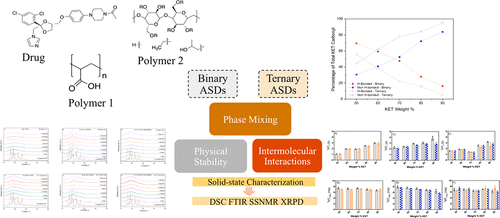当前位置:
X-MOL 学术
›
Mol. Pharmaceutics
›
论文详情
Our official English website, www.x-mol.net, welcomes your
feedback! (Note: you will need to create a separate account there.)
Investigation into Intermolecular Interactions and Phase Behavior of Binary and Ternary Amorphous Solid Dispersions of Ketoconazole.
Molecular Pharmaceutics ( IF 4.5 ) Pub Date : 2020-02-20 , DOI: 10.1021/acs.molpharmaceut.9b00970 Kanika Sarpal 1 , Cole W Tower 1, 2 , Eric J Munson 1
Molecular Pharmaceutics ( IF 4.5 ) Pub Date : 2020-02-20 , DOI: 10.1021/acs.molpharmaceut.9b00970 Kanika Sarpal 1 , Cole W Tower 1, 2 , Eric J Munson 1
Affiliation

|
Conventionally, amorphous solid dispersions (ASDs) have been formulated as a binary matrix, but in recent years a new class of ASDs has emerged, where generally a second polymer is also added to the formulation. Having the presence of a second polymer necessitates a comprehensive solid-state characterization to study the intermolecular interactions and phase behavior on a molecular level. With this goal in mind, ketoconazole (KET) was selected as a model drug, and hydroxypropyl methyl cellulose (HPMC) and poly(acrylic acid) (PAA) were chosen as polymeric carriers. The binary and ternary ASDs were characterized by differential scanning calorimetry (DSC), Fourier transform infrared (FTIR) spectroscopy, solid-state nuclear magnetic resonance (SSNMR) spectroscopy, and powder X-ray diffraction (PXRD). The binary KET:HPMC dispersions lacked any specific interactions, whereas binary KET:PAA dispersions and ternary KET:PAA:HPMC dispersions showed evidence for ionic and hydrogen bonding interactions. The 13C SSNMR deconvolution study established a comparison for molecular interactions between the binary KET:PAA and ternary KET:PAA:HPMC dispersions, with the binary KET:PAA system showing higher prevalence of ionic and hydrogen bonds than the ternary KET:PAA:HPMC system. Moreover, individual binary and ternary ASDs were found to be homogeneous on a nanometric level, implying the presence of a second polymer did not impact the phase homogeneity. In addition, a stronger interaction in binary KET:PAA and ternary KET:HPMC:PAA systems translated to better physical stability at different storage conditions. Through this case study it is recommended that a comprehensive investigation is needed to study the impact of using two polymers in ASD formulations in terms underlying intermolecular interactions and physical stability.
中文翻译:

酮康唑的二元和三元非晶态固体分散体的分子间相互作用和相行为研究。
常规地,无定形固体分散体(ASD)已经被配制为二元基质,但是近年来出现了新的一类ASD,通常在该制剂中还添加了第二种聚合物。由于存在第二种聚合物,因此有必要进行全面的固态表征,以研究分子水平上的分子间相互作用和相行为。考虑到这一目标,选择了酮康唑(KET)作为模型药物,选择了羟丙基甲基纤维素(HPMC)和聚(丙烯酸)(PAA)作为聚合物载体。通过差示扫描量热法(DSC),傅立叶变换红外(FTIR)光谱,固态核磁共振(SSNMR)光谱和粉末X射线衍射(PXRD)对二元和三元ASD进行了表征。二进制KET:HPMC分散体缺乏任何特定的相互作用,而二元KET:PAA分散体和三元KET:PAA:HPMC分散体显示出离子键和氢键相互作用的证据。13C SSNMR解卷积研究建立了二元KET:PAA和三元KET:PAA:HPMC分散液之间分子相互作用的比较,二元KET:PAA系统显示出的离子键和氢键比三元KET:PAA:HPMC系统更高。此外,发现单个二元和三元ASD在纳米水平上是均质的,这表明第二种聚合物的存在不会影响相均质性。此外,二元KET:PAA和三元KET:HPMC:PAA系统之间更强的相互作用转化为在不同存储条件下的更好的物理稳定性。
更新日期:2020-02-20
中文翻译:

酮康唑的二元和三元非晶态固体分散体的分子间相互作用和相行为研究。
常规地,无定形固体分散体(ASD)已经被配制为二元基质,但是近年来出现了新的一类ASD,通常在该制剂中还添加了第二种聚合物。由于存在第二种聚合物,因此有必要进行全面的固态表征,以研究分子水平上的分子间相互作用和相行为。考虑到这一目标,选择了酮康唑(KET)作为模型药物,选择了羟丙基甲基纤维素(HPMC)和聚(丙烯酸)(PAA)作为聚合物载体。通过差示扫描量热法(DSC),傅立叶变换红外(FTIR)光谱,固态核磁共振(SSNMR)光谱和粉末X射线衍射(PXRD)对二元和三元ASD进行了表征。二进制KET:HPMC分散体缺乏任何特定的相互作用,而二元KET:PAA分散体和三元KET:PAA:HPMC分散体显示出离子键和氢键相互作用的证据。13C SSNMR解卷积研究建立了二元KET:PAA和三元KET:PAA:HPMC分散液之间分子相互作用的比较,二元KET:PAA系统显示出的离子键和氢键比三元KET:PAA:HPMC系统更高。此外,发现单个二元和三元ASD在纳米水平上是均质的,这表明第二种聚合物的存在不会影响相均质性。此外,二元KET:PAA和三元KET:HPMC:PAA系统之间更强的相互作用转化为在不同存储条件下的更好的物理稳定性。









































 京公网安备 11010802027423号
京公网安备 11010802027423号